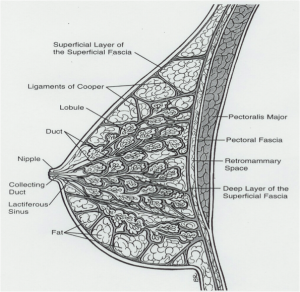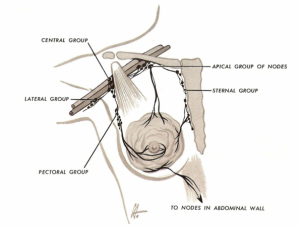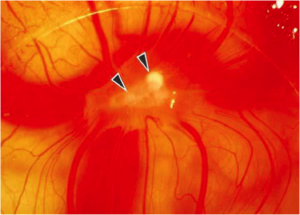Breast Health and Disease
Verna Hunt, DC, ND
Clinically, naturopathic medicine has much to offer women in proactive care of their breasts in concert with their entire health picture. Naturopathic modalities applied to lifestyle and healthcare choices promote breast wellness.
My clinical interest in breast health began over 30 years ago, when several young female patients in their 30s, still breastfeeding, developed breast cancer and died, leaving a spouse as a single parent with young children. This is a tragic situation for the family and for society in general that leaves us without the benefit of what these women could have contributed in their lifetime. I began in earnest to seek ways to treat and educate women on how to proactively regain and maintain their breast health through naturopathic care. One of the applications this search led me to was digital infrared imaging (DII), or breast thermography. This burgeoning technology has been used from about the 1970s onward, with mixed reviews. Currently, the quality of the technology and the certification of the interpretation of the results vary from very poor to excellent. I sought out experts who performed DII and began using this as a clinical laboratory test around 1995 by referring patients to a thermologist in Detroit, Michigan, certified by the American Board of Thermology. As there were not any certified thermography services in Canada, specifically in the Toronto, Ontario, area, I cofounded a company in 2001, Medical Thermography International Inc, so that reputable scanning could be available throughout Canada. In 2003, I gave up the ownership of this company, and today I act as the medical consultant for physicians who utilize thermography in their patient care.
Years of teaching and advising healthcare practitioners what to do with the thermology report information have shown how many of them still regard breast health from an allopathic point of view by solely looking for pathology such as cancerous tumors. Many NDs find it difficult to understand that DII or cold challenge thermography does not detect cancer. This confusion is also demonstrated in some of the current breast thermography research and its interpretation. Digital infrared imaging measures the changes in the vascular function, looking for neoangiogenic vessel activity that indicates the possibility of tumors. It tests the function, not the structure of breast tissue, and does not take the place of case-indicated ultrasonography or mammography.
The Context of Breast Health and Disease
Long before the manifestation of breast cancer, there is breast tissue dysfunction. Breasts are an “early warning system” that something is going wrong within the body’s entire homeostasis. This can begin with premenstrual breast tenderness, occasional nonspecific nipple discharge, fibrocystic breasts, soreness most of the time, and on to palpable masses. Current statistics show that 1 out of 4 women will have some form of breast cancer in her lifetime. Although 77% of breast cancers occur in women over 50 years old, younger women more than ever before are affected. Of the women who are diagnosed with breast cancer, 70% have no genetic history of breast or ovarian cancer. Of all forms of cancer in women, 26% are of the breast, and among deaths due to cancer, 15% are of the breast; this mortality has not changed in the last 50 years. Breast cancer rates increased 40% between 1973 and 1998. Some would call this soaring increase an epidemic.
Many theories about why breast cancer is increasing exist, including the following: more frequent and technically advanced screening with mammography finds more cancers, increased environmental pollution load causes abnormal cell function, greater use of prescription drugs (including birth control pills) alters the endocrine balance, wearing restrictive bras raises the incidence, and general increases in total body burden of toxins affects the filtration ability of the liver and kidneys.
Proactive breast healthcare begins long before a mass can be felt by touch or seen in an ultrasonography scan or a mammography radiograph. Consider what has evolved in proactive dental healthcare over the years. When you ask patients if they floss and brush their teeth, most will reply yes. When asked why they floss and brush, they will say to prevent cavities. Yet, when you ask women if they practice preventive or proactive breast health, they generally do not know what this means or say, “Yes. I get mammograms.” The use of mammography does not prevent cancer; it assesses for cancer. Clearly, breast cancer begins long before tumors detected on mammography alert us to the possibility of cancer.
As 70% of breast cancer occurrences are not genetically based, this means lifestyle and healthcare choices that women make can realistically be optimized throughout their lives to affect their breast health. The naturopathic profession can redefine the context of what is normal in breast health by educating women about healthy breast tissue, engaging their breasts as an integrated part of the whole body and promoting self-care from puberty through elder maturity, including aspects such as budding growth at puberty, pregnancy and lactation, and postmenopausal care.
Breast health monitoring currently begins at a late stage of disease development, when structural changes (lumps) are measured with mammography. After speaking with a broad spectrum of women over many years, I find most women think that breast function does not affect their day-to-day lives and pay little attention until something obvious has gone wrong. Women perceive their breast function as serving as a decoration or a sexual object for someone else’s enjoyment, as providing food for infants, or as being “cancer holders.” Many women express that they are just waiting for the cancer to occur and in some cases have both breasts removed prophylactically even without a genetic history of breast cancer and with no positive results in laboratory predictive tests. Women tell me they often do not want to “think” about their breasts because to them it means looking for cancer. Women also tell me they ignore their breasts more than any other part of their body. They do not have knowledge about how to change the context of how they view their breasts and to look after them as part of their entire being. Naturopathic physicians can teach women how to do this.
The appearance of breasts can vary as widely as facial features. To view nonsexual pictures of breasts, go to www.007b.com. When women tell me they do not “like” their breasts, I recommend this website and counsel them on acceptance of their unique expression of breasts.
The Anatomy of What Goes Wrong

Breast tissue develops between the subcutaneous layers of the skin, where “breast buds” surround and branch out from the areola. At puberty, these buds are stimulated to grow mainly by estrogen and somewhat by progesterone. Today, this is happening to females at younger ages and to males as they age due to the xenoestrogens absorbed largely from environmental sources. Breast tissue is actually a modification of lymph tissue and sweat glands. In fact, breast milk has evolved from a form of modified sweat. The milk drains forward through a series of ducts to the central nipple when stimulated by the sucking of the infant. In a way, it acts as a specialized emunctory, which is important when considering the underlying causative factors of ductal carcinoma in situ vs other breast tumor forms.
The breast sits over the pectoral muscles; at the back of the breast tissue, a retromammary space receives the drainage of lymph fluid from the breast, which empties up toward the armpit. This lymph that follows up and under the area is known as the “tail” of the breast.
Drainage of the lymph and venous system is very important in breast health. Congestion of the body’s emunctories affects the lymphatic and venous drainage systems. This leads to increasing stagnation of the end products of cellular metabolism within the cells and in the interstitial spaces. Eventually, the stagnation affects the arterial system’s ability to flow normally and deliver nutrients. With this, the breasts can become tender, which is a form of chronic inflammation that will overtax the ability of the immune system to clean up. It may also be an indication that the liver is not completely breaking down the body’s load of hormones when they are at the end of their usefulness. As a result, the breast cells are repeatedly reexposed to excess estrogen and progesterone, in some cases promoting abnormal cell function.
In reality, no one knows what the mix of environmental toxins is doing inside any area of the body, but the breast seems to be extremely vulnerable. When the innate homeostasis is disrupted by physical or nonphysical stressors or trauma, the gene expression changes, and the normal cells can begin to express themselves abnormally. Normally, the immune system kicks in to destroy these metaplastic or abnormal cells. Without this immune action, a tumor grows, and when it reaches about the 2-mm size, the vascular system develops neoangiogenic vessels in order to be able to constantly feed the abnormal cells outside of the body’s homeostatic self-regulatory control. Normal blood vessels contain smooth muscle under the control of the autonomic nervous system. One function this allows for is the homeostatic control to signal the vessels to contract in cold temperatures or to expand in hot temperatures. In neoangiogenic vessels, there is no master control via the nervous system, and the tumor is allowed to feed and grow no matter what is happening in the rest of the body.
Screening vs Detection and Function vs Structure

Ultimately, a biopsy is the only way to diagnose breast cancer, and to find something to biopsy, there has to be a mass big enough, at least 2 mm, to detect. The assessment to detect a mass or structural change could involve manual palpation, ultrasonography, and radiological mammography, as well as perhaps by magnetic resonance imaging or positron emission tomography in the future. Research indicates that cancer doubles on average every 90 days, and at this rate neoangiogenic vessels form at about 2 years after the first cancer cell has formed, but detection of a structural mass may not occur until 5 to 8 years, when there are 1 to 5 billion cancer cells.
The goal within naturopathic medicine is to treat the cause and to find functional changes long before tumors grow to this size. Beyond symptoms and manual examination, how do NDs screen for dysfunctional breast tissue?
Self-screening for structural breast changes can begin by mindful touching. Recommend that girls start at puberty mindfully touching their breasts regularly, during a shower or bath, just as they would wash any other body part such as their face. If there was a new pimple on their face, they would know by touch when washing it, and it should be the same with their breasts or any other body part. The approach to this is with an attitude of greeting and appreciating vs looking for something wrong. Even with young children, encouraging them when cleaning their body to say, “Good morning, body” or “Hello, elbows! How are you doing?” keeps them in a mindful state and helps them learn to appreciate their body throughout their entire life. Paying attention to and appreciating one’s body helps people notice changes.
Many allopathic medical investigators question whether women should perform breast self-examinations. Granted, it is more difficult for the average person to distinguish abnormal lumps from benign fibrocystic breast lumps or other textures. Anyone who has ever taken birth control pills will tend to have fibrocystic breasts. Yet, when women regularly feel their own breasts over time, they get to know what the terrain of their breasts feels like and can often sense any changes. Depending on the research, some investigators report that more women find their own lumps compared with any other screening method.
When I started on the quest of proactive breast health practices, I wanted to preempt detection and find a technology that screened for early dysfunctional processes in the physiology of the breast tissue, which could be used as a biological risk marker. Breast thermography elicits functional information by using a cold challenge to measure functional changes in breast tissue circulation. It screens for neoangiogenic blood vessel–like responses that may be feeding a possible tumor growth. I use the following 3 criteria to determine if the equipment, thermography technician, and thermologist are competent:
First, the thermologist must be certified by the American Board of Thermology to read and report according to the international standard, the Marseille System of Classification. In 1975, based on the results of investigations at the prestigious Pasteur University in Marseille, France, this objective analytic system was established for reporting breast thermology scans. Today, this reporting system has been refined by enhanced knowledge of basic science and increased clinical experience but remains the basis for breast health analysis. The Marseille System of Classification grades on a TH-1 (normal) to TH-5 (severely abnormal) scale as a summary based upon specific, objective, and quantitative thermal features and differential levels of infrared energy. A certified thermologist’s training takes many years, equivalent to that of a radiologist. Watch for equipment companies selling thermography equipment that also certify thermologists as they are in conflict of interest.
Second, the thermography technician who performs the scanning procedure must be trained and certified, independent of any equipment company, by the American Board of Thermology and perform procedures according to the Marseilles system. One of the most important criteria is that the patient having the scan must have a cold challenge, where the hands are put in water at 11°C for 1 minute in between the pre and post scans. Comparing these 2 scans, the thermologist determines if any neoangiogenic activity is identified that indicates the possibility of tumor growth. If graded as TH-3, TH-4, or TH-5, the physician sends the patient for ultrasonography to determine if there is any structural mass present. If there is a mass and it has tumor characteristics, mammography is indicated.
Third, the equipment used is a radiometric infrared camera that performs quantitative thermal measurements of a patient’s emitted infrared energy within the firmware of the camera by continuously calculating digital temperature measurements through a large thermal span. The radiometric infrared camera should also provide for thermal drift compensation that guarantees the temperature measurements are stable and accurate at all points within the camera’s operating temperature range. Radiometric infrared cameras should be considered quantitative instruments as they produce digital temperature measurements internally and output these data to the computer rather than requiring the computer’s software to perform an interpolation of the temperature values.
Consultation, Examination, and Naturopathic Care

Atypical pre-cancerous cells growth rate
● 90 days 2 cells (Cancer cells double in number on average every 90 days)
● 1 year 16 cells
● 2 years 256 cells (Angiogenesis occurs around this point)
● 3 years 4,096 cells
● 4 years 65,536 cells
● 5 years 1,048,576 cells
● 6 years 16,777,216 cells
● 7 years 268,435,456 cells
● 8 years 4,294,967,296 cells (doubled 32 times)*
*Most cancers are detected by mammography at this point – when the diameter of the tumor is about 1cm (about the size if a dime) and contains over 4 billion cells.
Source: Buchanan JB, et al. Tumor growth, doubling times, and inability of the radiologist to diagnose certain cancers. Radiol Clin N Am. 1983;21:115-26
During consultation, particular factors to consider with respect to breast health include events and risk factors. Events to consider are pregnancies, abortions, births, breastfeeding, mastitis location and treatment, fertility issues, and the use of prescription medications or other therapies. Risk factors to consider are numerous and include the following: male relatives with prostate or breast cancers, light-skinned women, birth weight and length higher than normal, tall height in adulthood, obesity, high body mass index, very early childbearing, never breastfed, chronic inflammation, immune deficiency, allergies, prescription drug use, environmental exposures and hormonal disruptors, dental problems, hormonal imbalance, insufficient or processed food intake, constipation, lack of exercise, breast implants, smoking, hair dyes, toxic body care and laundry products, wearing a bra long hours or impeding lymph drainage, trauma to the breast tissue, and psychological and spiritual issues, in addition to the standard questioning about female relatives with breast, ovarian, or endometrial cancer.
Questions addressed toward breast health help women consider what is happening with their breasts. Ask the following questions again at return care appointments to guide women on proactive care:
- What is your feeling or opinion about your breasts?
- Do you experience your breasts as part of your body?
- Have you ever had breast pain?
- Are you comfortable in the bras that you wear?
- Can you take a full breath into your belly and low back when wearing your bra?
- What emotions do you associate with your breasts?
- Do you engage in healthy breast practices?
- Have you noticed any changes in your breast or chest tissues? Ask men this too.
During a new patient physical, examine the chest and breast area in both men and women in order to gather a more complete view of the patient’s health status. Clinical breast examinations and mapping are best performed 1 to 2 times per year to keep updated on tissue changes that may otherwise go unnoticed. Explain to the patient all aspects of the examination prior to the event, and ensure that the patient is comfortable about what is going to happen. In addition to checking the actual breast tissue in positions of sitting, arms raised and neutral, and body supine, include palpation of the lymphatic system such as the following: surrounding muscle and bone structure, endocrine system, abdominal organ size and texture, and other manual tests related to the endocrine and filtration systems, as well as the standard examination of armpits, thoracic duct, belly, low back, groin, and legs. Laboratory testing should be performed for function and toxicity, including blood, live blood cell, hair tissue mineral analysis, urinalysis, salivary hormones, and so forth. Most important, send women for yearly infrared breast thermography scans, and learn how to utilize the thermology report results to make strategic decisions about the best individualized naturopathic care for each patient. For women who have had breast surgery, including implants and mastectomies, thermography can monitor breast tissue or scar tissue function 3 months after the surgery and onward throughout their lives.
Naturopathic care can have a great impact at early stages of dysfunction. Teach the following breast self-care therapies:
- Total body dry skin brushing to stimulate drainage of the lymphatic system
- Organic castor oil packs applied from the breast to the pubic area using low heat for 30 minutes 3 to 4 times per week for 3 to 4 weeks initially and then twice per month (not during menses)
- Lymphatic drainage cream or breast oils applied to breast tissue, including the axilla, up to the collar bone, and a few inches down the midriff area, to stimulate lymph drainage of tissues
- Food intake avoidance of processed foods (organic when possible), limited dairy and caffeine, and consumption of cruciferous vegetables and 20 to 30 g of fiber per day
- Fluid intake comprising half the body weight in fluid ounces of clean water each day
- Use of supportive but unrestrictive bras
- Exercise, including total body cardiovascular and stretch and strengthening (yoga, Pilates, walking with Nordic poles, and vibrational weight-bearing therapy machines)
Therapies administered or monitored by NDs include the following:
- Manual breast massage and lymphatic drainage
- Hydrotherapy in concert with each individual’s total body needs
- Colon hydrotherapy to release the toxic load
- Saunas and other detoxification programs
- Balancing of endocrine function and optimal function of the emunctories (liver, kidneys, lungs, skin, uterus, etc) through individualized supplement programs using botanicals, homeopathy, enzymes, vitamins, minerals, and so forth
In Conclusion
The naturopathic profession can help patients care for their breasts and have healthy breasts for a lifetime. Naturopathic medicine inherently holds the vanguard to proactive breast healthcare.
 Verna Hunt, DC, ND has been practicing as a chiropractic and naturopathic physician for over 30 years. She owns and operates The Centre for Health and Well Being in Toronto, Ontario, Canada, established in 2005. She acts as a medical adviser to colleagues and companies that service holistic healthcare. Dr Hunt writes, speaks, and teaches, presenting through her organization Being Well Communications.
Verna Hunt, DC, ND has been practicing as a chiropractic and naturopathic physician for over 30 years. She owns and operates The Centre for Health and Well Being in Toronto, Ontario, Canada, established in 2005. She acts as a medical adviser to colleagues and companies that service holistic healthcare. Dr Hunt writes, speaks, and teaches, presenting through her organization Being Well Communications.


